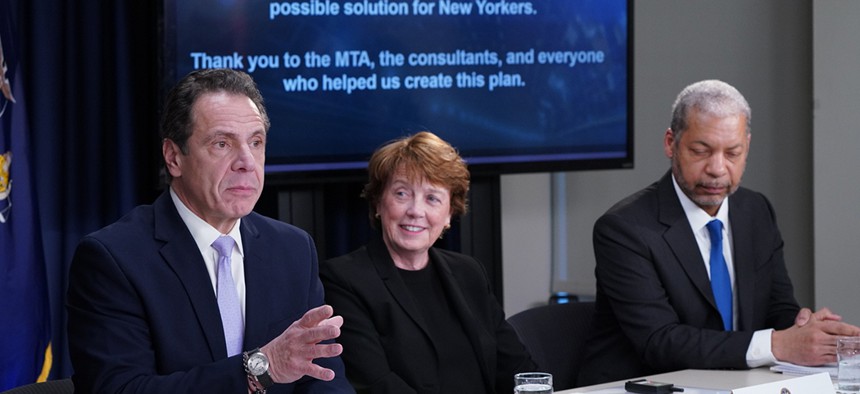Two and a half years after the L train shutdown was first announced and a few months before it was set to begin, Gov. Andrew Cuomo said Thursday that the L train doesn't have to close after all.
Instead, the Metropolitan Transportation Authority, which Cuomo effectively runs, plans to close the subway line on just nights and weekends to conduct repairs to the tunnels under the East River that were seriously damaged from Superstorm Sandy in 2012. Cuomo said the new plan was possible thanks to a “highly innovative” design suggested by “some of the best minds in the world.”
Last month, Cuomo toured the tunnels, known as the Canarsie Tube, with engineering experts and said they would review the findings. Still, Thursday’s announcement came as a surprise, even to plugged-in transit reporters, most of whom seemed to be tipped off by a tweet from the national TransitCenter foundation.
RUMOR MILL this morning: Cuomo may announce L train shutdown is unnecessary later today
— TransitCenter (@TransitCenter) January 3, 2019
One person did get a slight heads up: New York City Mayor Bill de Blasio, who told reporters at an unrelated press conference Thursday that he had spoken with the governor earlier in the day. De Blasio said he needed more time to evaluate what the announcement meant, but seemed broadly optimistic. “Anything that avoids disruption, I favor, obviously,” he said. “If there’s a plan that can be better for the people of our neighborhoods, that’s great.”
Others weren’t so grateful. Gov. Andrew Cuomo may have been expected the news to receive an enthusiastic welcome, but it was instead greeted with the weary skepticism of a city accustomed to disappointment at the hands of the MTA.
Former New York City Council Speaker and current public advocate candidate Melissa Mark-Viverito complained that the announcement came after residents and businesses planned for a full shutdown.
Um, what? Of course everyone wants the subway fixed quickly & running smoothly, but the MTA and the Governor owe New Yorkers the truth about why this new plan came so late in the game. Families moved neighborhoods, businesses suffered, & suddenly the Governor says—just kidding?
— Melissa Mark-Viverito (@MMViverito) January 3, 2019
In a statement, New York City Councilman Rafael Espinal, who represents many of the affected neighborhoods in Brooklyn and is also running for public advocate, argued that the city’s contingency plans should be kept in place. “The city should go ahead with its plans to ease that pressure even if the L Train won’t be completely shut down,” Espinal said. “Things like expanding the network of bus and bike lanes and extending CitiBike further into Brooklyn are good proposals and still necessary so the city should push ahead with them.”
Straphanger advocate John Raskin, executive director of the Riders Alliance, was also wary of the governor’s plan. “The governor's plan may or may not work,” he said in a public statement. “But you'll pardon transit riders for being skeptical that a last-minute Hail Mary idea cooked up over Christmas is better than what the MTA came up with over three years of extensive public input.”
New York City Councilman Antonio Reynoso, who represents North Brooklyn neighborhoods serviced by the L train, likewise questioned Cuomo, showing concern for New York City Transit President Andy Byford, who had been leading L train shutdown plans.
On vacation i get the news the Ltrain shutdown will be halted. Full statement when i get back to NYC Monday and have more details. One thing for certain, Cuomo runs the MTA. Also, Byford is made to look foolish as his plan for the L train is second guessed.
— Antonio Reynoso (@CMReynoso34) January 3, 2019
Others, like transit blogger Benjamin Kabak, asked whether Cuomo went over Byford’s head on the decision.
A few off-the-cuff thoughts:
— Second Ave. Sagas (@2AvSagas) January 3, 2019
- Andy Byford should resign one of these days in protest
- The "experts" used by Cuomo are already personas non grata at the MTA, and this is just going to make this worse. I wonder if Cornell and Columbia realize this.
But Byford himself seemed to still be in charge of the granular details when he huddled with reporters after the announcement.
Transit President Andy Byford likes the new plan. Here he is talking about elevator improvements (still happening) and G train lengthening (which he still wants). pic.twitter.com/du9eQH3yLP
— Vincent Barone (@vinbarone) January 3, 2019
Many of those details are still being worked out, and state Sen. Brad Hoylman, who represents areas served by the L train in Manhattan, put in his two cents in a tweet that got many unhappy responses.
The L train rethink will be a major win for public health & the environment because it eliminates the need for 200+ diesel buses streaming through our neighborhoodshttps://t.co/75wN8R7ttX
— Senator Brad Hoylman (@bradhoylman) January 3, 2019
Night and weekend shutdowns will mean even more private cars and FHVs on the road for a longer amount of time, causing far more emissions than 200 shuttle buses would.
— Chris O'Leary (@ohhleary) January 3, 2019
One thing reporters could suss out for sure: Cuomo runs the MTA, despite what he says.
"No, I am not in charge of the MTA," Cuomo says as he announces what the MTA will be doing, which is what he wants.
— Shane Goldmacher (@ShaneGoldmacher) January 3, 2019
Governor Cuomo is trying to simultaneously get credit for a new plan that prevents a full shutdown of the New York City MTA's L-Train tunnel (between Brooklyn and Manhattan) while saying “no, I am not in charge of the MTA."
— Jimmy Vielkind (@JimmyVielkind) January 3, 2019
To which Cuomo’s senior advisor Rich Azzopardi suggested that maybe we should all just be a little happier about the change of plans.
I get the impression that negativity may just be a default for some people here.
— Rich Azzopardi (@RichAzzopardi) January 3, 2019
NEXT STORY: Federal judge blocks NYC Airbnb disclosure law


